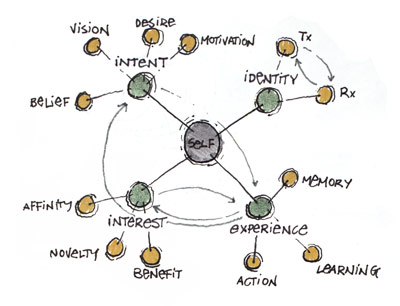A Theory of Community Formation
As part of our work at The Value Web, we’ve been involved over the years working with various communities – such as The World Economic Forum’s Young Global Leaders community – to organize numerous community gatherings and create processes that achieve particular outcomes or explore areas of interest.
More and more, however, the creation of community has become an end in itself, as the people we work with come to recognize the value of strong and engaged communities of people and their ability to achieve what disconnected groups cannot. While we have intuitively designed using our core models in a way that has nurtured communities through shared experience and work, I have found myself wanting a meta-model that would aid in explicitly designing for community formation.
The theory and model presented here is an early version towards having a design toolkit for community formation; it is based on a number of underlying theories and assumptions. The first assumption is that any community or potential community is a complex system, based on the fact that it is made up of a series of independent actors with their own influences and interactions. Secondly, it is based on the idea that community itself is an emergent quality – community, per se, does not exist; it is a perceived connection between a group of people, based on overlaps of intent, identity, interest and experience.
Which brings us to the model; as the model is in its first iteration, it is still in two parts; there is the individual, and there is the community. The idea is quite simple; individuals are the component parts of the community, and the community is based on the creation of connections or overlaps between the individuals.
The aspects of the individual that have been pulled out for the purposes of this model are the ones that are relevant to our sense of self in relation to others and groups, as well as those aspects which form a basis for connection. These aspects are interest, experience, identity and intent. These elements have, between them, a series of complex interplays, and I believe there are a number of archetypal interactions between them both for the self, and in the connect between people, that will be part of the next iteration of the model. For now, in this version, each particle within this “molecular” model of the self has multiple sub-components which dictate the behaviour of the particle.
Interest
Interest is meant in two senses of the word; first, in the sense of attraction or affinity to something as engaging, and second, as something perceived to be of benefit to the individual. Interest is a motive force which guides action.
Experience
Experience is the retained memory of past actions and senses. As it accumulates it begins to work in a feedback loop with interest and intent, but also begins to form a basis for identity, in that we become a collection of what we have done.
Intent
Intent runs deeper than interest – it is more complex and nuanced, in that it combines the drives of interest with the insights of experience to create a broader, vision-based set of motivations. Belief plays a role in intent, and intent, where forms, becomes embedded in identity.
Identity
Identity, in this model, is a purely emergent quality. It is presented as the interplay between our own self-perception which is “projected” into the world, and the received “reflection” from others as our projected self is validated, challenged and shaped. Identity, which we craft from our experience (“who have I been?”) is a balance between who we say we are, and who we believe others think we are.
The social aspect of identity is critical here, when we think of this model in the context of community formation. The most robust communities become so because the community has become a constituent element within its members’ self perception.
Forming Community
The concept of community formation within this model, then, is that communities can form based on the overlaps between these elements among a number of people. There are different archetypes of formation here – communities of interest, alumni (based on past experience), movements and causes (based on intent). Part of my contention here is that a community that is designed could be designed for resilience by sequencing and overlaying the different types of formation – once the development of a community has gone from loosely based on interest, then grown through shared experience, then catalyzed through intent (or multiple intents, mapped back to interest) would become a major identity vector among members. This delicate weave is what begins to create not a gathering, but a community, whether it be online or off, geographically based or transnational.
There is much more to the model, in particular the archetypes, but I’ll save them for a subsequent post. I am curious, first and foremost, to get the insights of others on how they have seen communities form; does the model hold? What’s missing?




37 Responses to “A Theory of Community Formation”